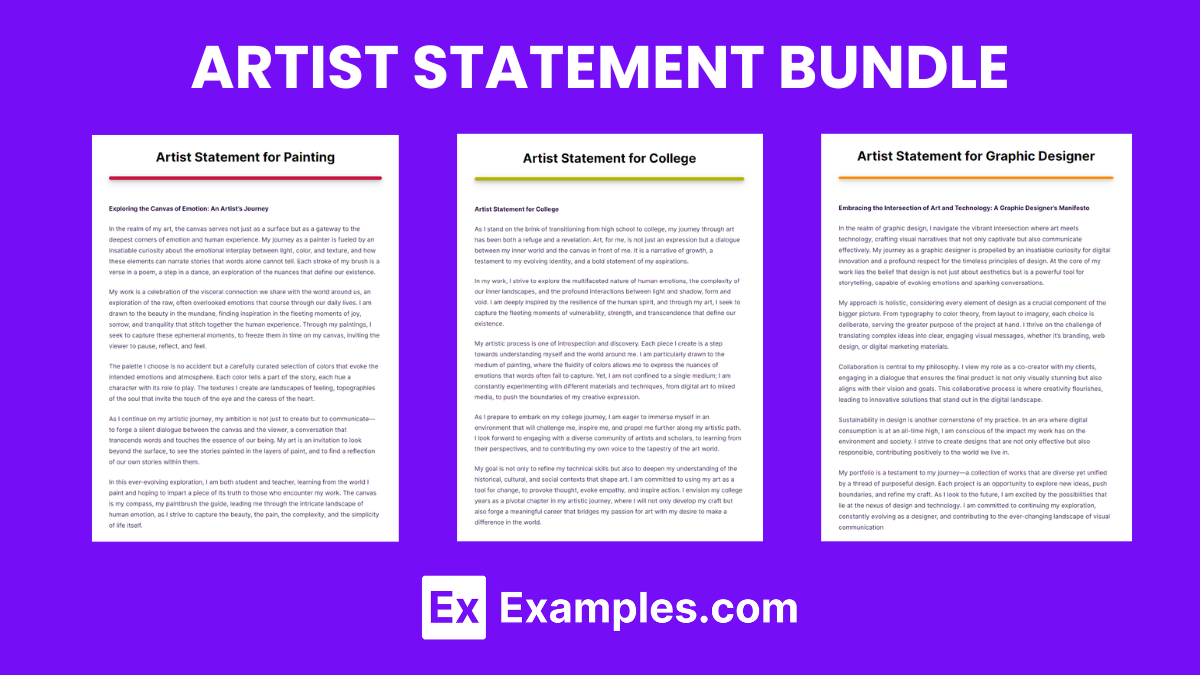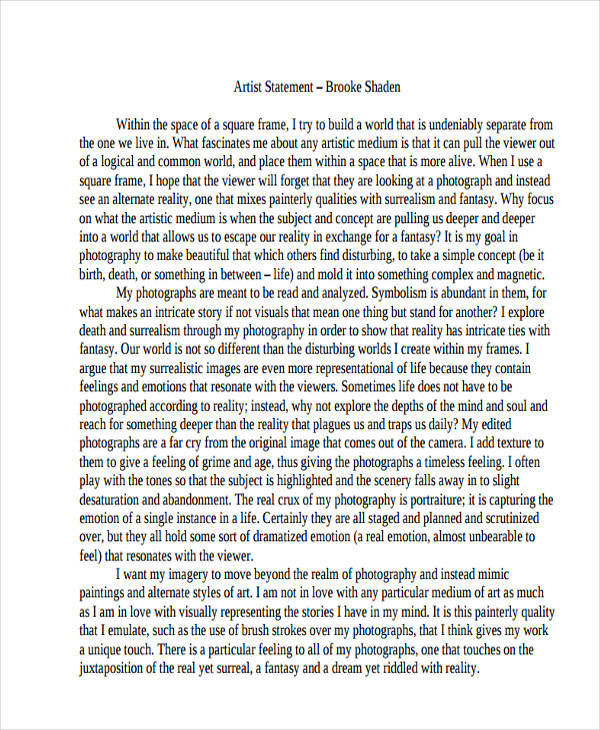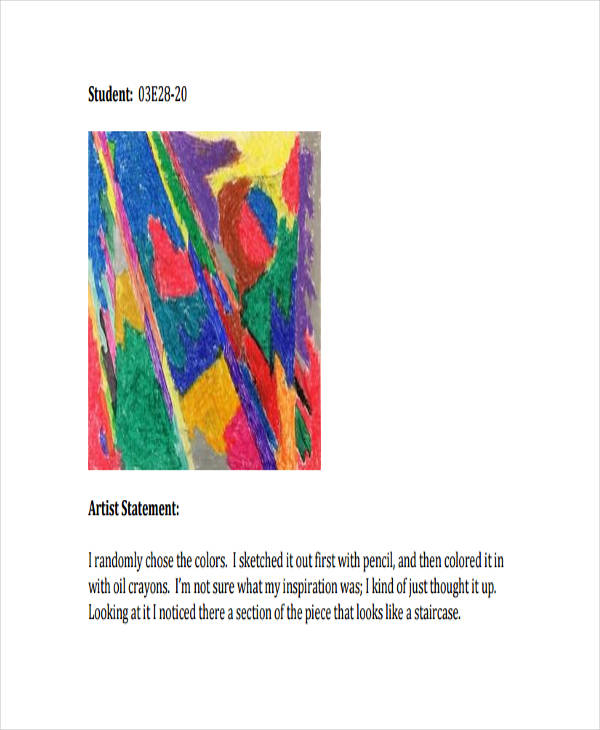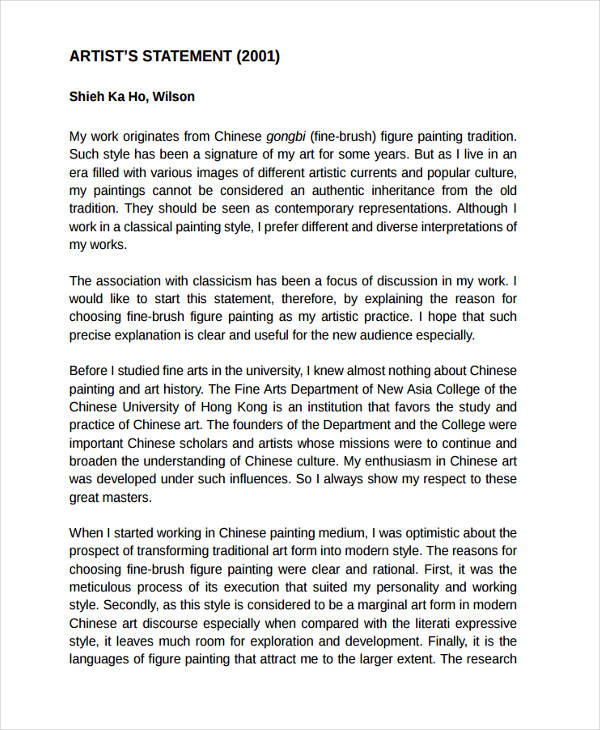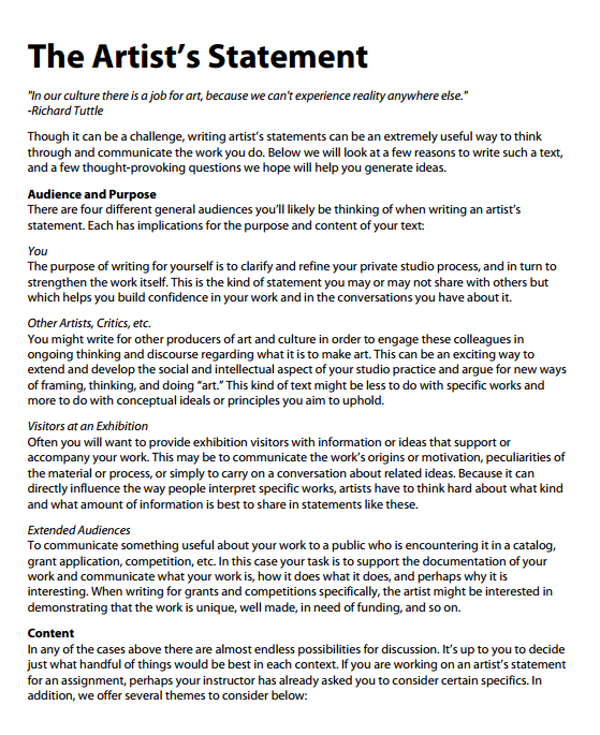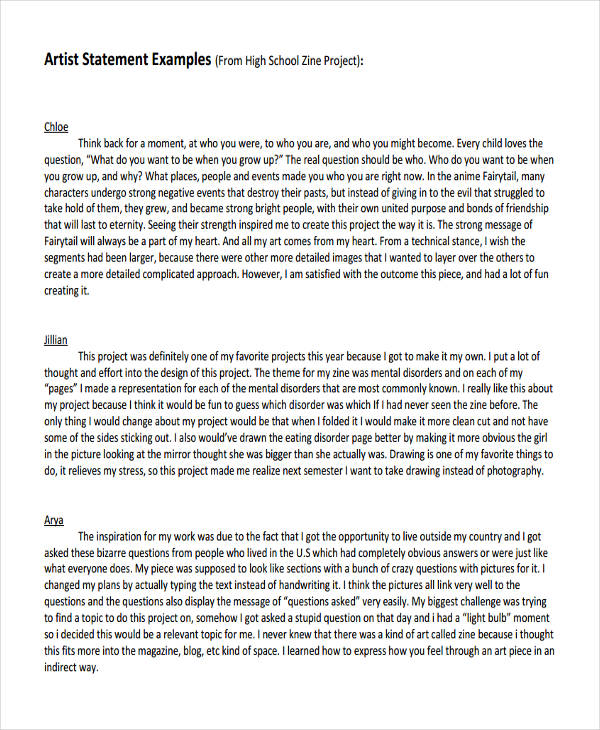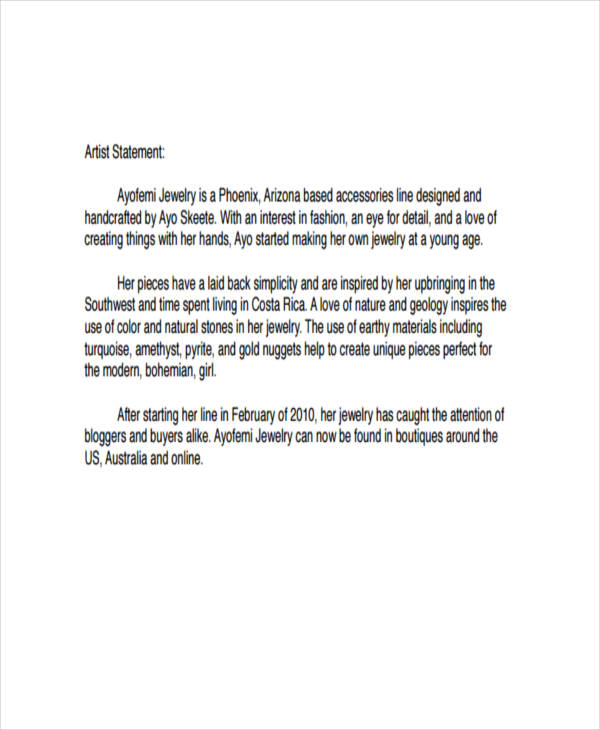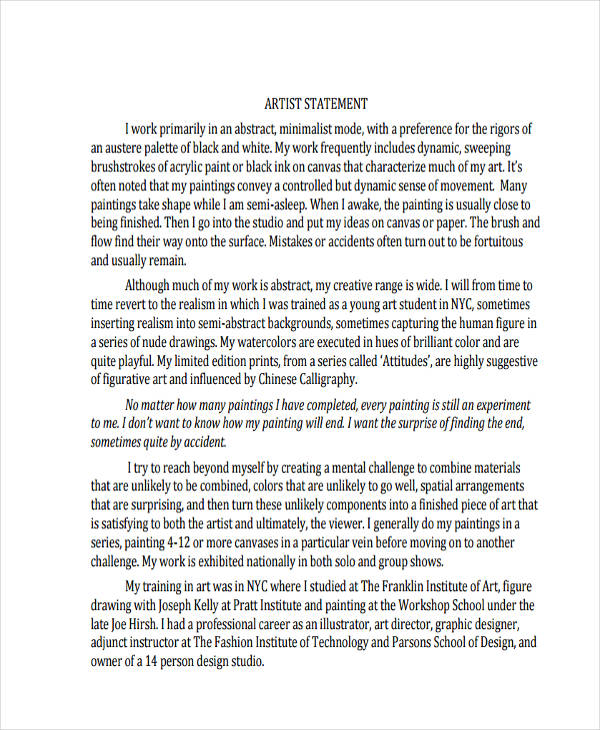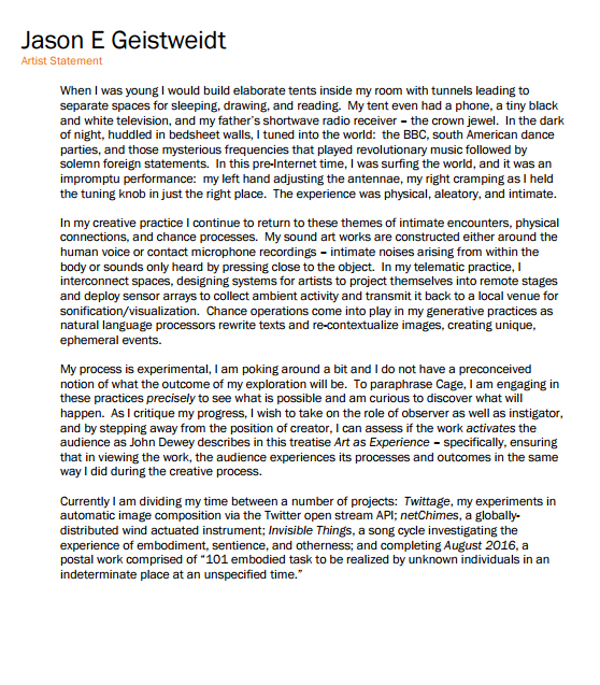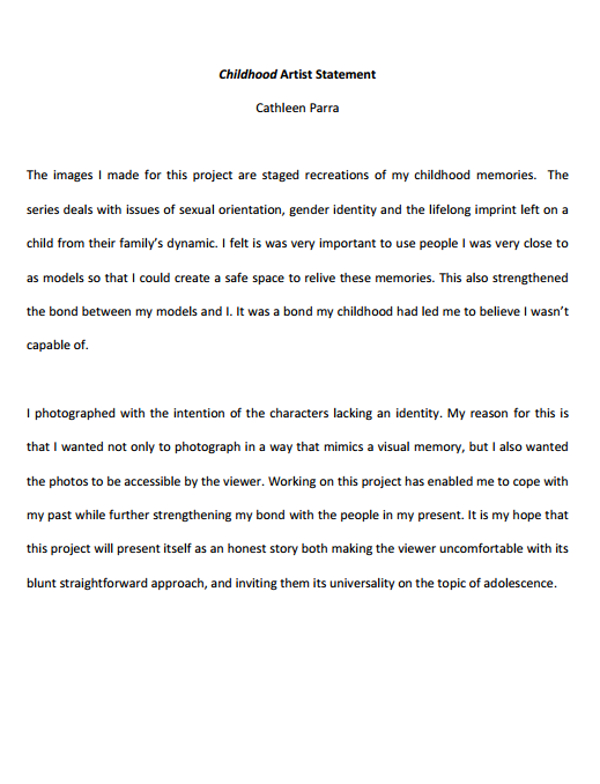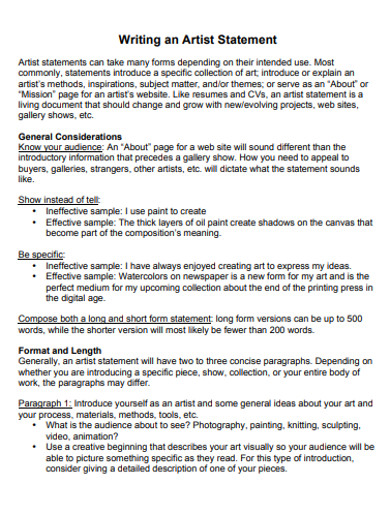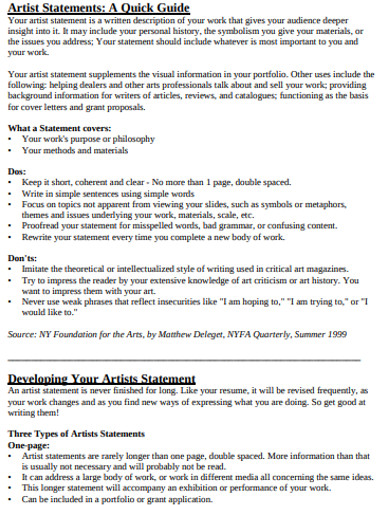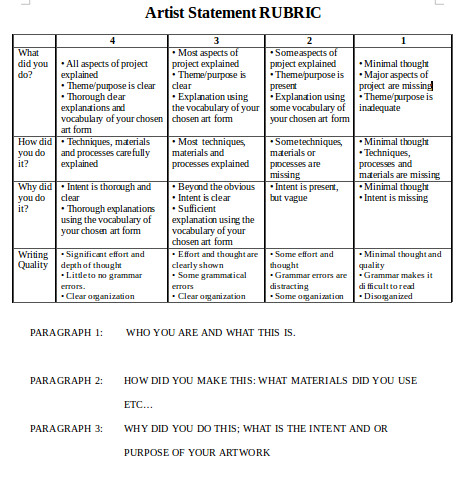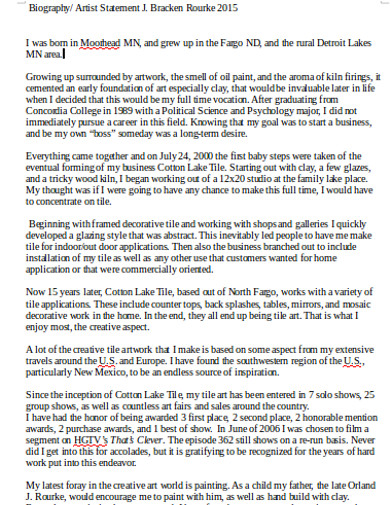25+ Artist Statement Examples to Download
Aside from the colors of your background and the strokes of your brushes, there is also an important aspect of art which is not drawn or painted but written. This is what we call the artist statement, and this document shows an overview of the artist’s interpretation of his/her work. If you are an artisan that is going to exhibit an artwork in a gallery, you might be needing an artist statement, too. In that case, read through this article to create your own statement like a pro.
You don’t need to be a writer to create a good quality artist statement. You just have to look into your art or piece of work and find its relevance and purpose. And by then, you can create your own artist statement. To help you with that, you can check out our different formats like statement examples in pdf.
An artist statement is a brief written description provided by an artist that offers insight into their work. It serves as a personal reflection on what drives the artist’s creative process, the themes and subjects they explore, the techniques and materials they use, and their overall artistic goals. The statement helps viewers understand the context and intentions behind the artist’s work, bridging the gap between the artist and their audience. It’s an essential tool for communicating the essence of the artist’s practice, often accompanying exhibitions, portfolios, and promotional materials.
Start with Your Motivation
- Explain Why: Begin by discussing what motivates you to create art. What drives your creativity? This can include your passions, experiences, or the questions you seek to explore through your art.
Describe Your Process
- How You Create: Talk about your creative process. Do you use any unique techniques or materials? How do these choices influence the final outcome of your work?
Elaborate on Your Themes
- Themes and Subjects: Detail the themes, subjects, or concepts your art explores. How do these reflect your personal beliefs, societal observations, or interests?
Discuss Your Influences
- Inspirations: Mention any artists, art movements, real-life events, or personal experiences that have significantly influenced your work. How have these influences shaped your artistic perspective?
Reflect on Your Goals
- Artistic Goals: Reflect on what you aim to achieve or communicate through your art. What do you hope the viewer gains, feels, or understands after experiencing your work?
Keep It Accessible
- Language and Length: Use clear, straightforward language that can be understood by people outside your field. An artist statement should typically be concise, ideally one page or less.
Personalize It
- Unique Voice: Ensure your statement reflects your unique voice and personality. It should feel as authentic and individualized as your art itself.
Revise and Refine
- Edit and Feedback: After writing your draft, revise it for clarity, coherence, and impact. It’s also helpful to seek feedback from peers, mentors, or others in the art community.
Examples for Inspiration:
- “My art explores the relationship between modernity and nature, questioning our disconnect and highlighting the beauty in the overlooked. Through mixed media, I seek to create a dialogue about sustainability and our role in the ecosystem.”
- “Driven by the complexities of human emotions, my sculptures serve as a physical manifestation of what we often struggle to express verbally. Using reclaimed materials, I aim to show the beauty in imperfection and the stories.
Short Artist Statement Examples
Example 1: Abstract Painter
“I channel the chaos of emotion and thought into vibrant abstract paintings. My work is a dialogue between color and form, seeking harmony within the tumult.”
Example 2: Nature Photographer
“Through my lens, I capture the silent whispers of nature, focusing on the often-overlooked details that embody the essence of beauty in the wild.”
Example 3: Ceramic Artist
“My ceramics blend functionality with a touch of whimsy, drawing inspiration from the organic forms of nature to create pieces that celebrate the joy of everyday life.”
Example 4: Digital Illustrator
“I navigate the intersection of fantasy and reality, creating digital illustrations that delve into the surreal and explore the boundless potential of imagination.”
Example 5: Jewelry Designer
“Each piece of my jewelry tells a story, crafted with care to weave together the timeless elegance of nature with the intricate tales of our lives.”
Photography Artist
Student Artist Example
Poetry Artist Sample
Painting Statement Example
Painter Artist Statement
Example Artist Statement
High School Artist
Jewelry Artist Sample
Abstract Statement Sample
Personal Artist Statement
Childhood Artist Statement
Basic Artist Statement in PDF
Standard Artist Statement in PDF
Formal Artist Statement in DOC
Artist Biography Statement in DOC
What Does an Artist Statement Mean?
An artist statement is a comprehensible, descriptive and free composition which also acts as an introduction about a certain artwork that is usually displayed in front of the portrayed artist’s creation. Its main purpose is to give the viewers or readers a complete understanding of the artist’s work and its concept statement. In its simplest sense, it is a writing that shows an overview of the artist’s interpretation of his/her work. Typically, the basic ideas of a described work are opened in an overview that is composed of two to three sentences or in a brief paragraph. Furthermore, it is in the second paragraph where the depictive details of the work are concisely discussed.
How long is an artist statement?
Art experts suggest that the best length for a published artist statement is typically between 150-200 words. This bracket of word numbers is enough for an artist to express his/her interpretation of his/her artwork, but also not too long that would bore and distract the audience. Nevertheless, some of the artists limit their statements in two to three sentences. The artist statement can change throughout the artist’s career and as time passes by, these statements are maintained and also revised.
How to Conclude an Artist Statement
An artist statement overall provides clear and simple context without the use complex terminology. However, some artist prefers to make their statement deep and “thought-provoking” that is suitable for their abstract work of art. Nevertheless, they all end it with a strong summary writing of their art. Here’s how to close an artist statement.
1. Summarize the whole content of your artist statement in a short paragraph.
2. Express the relevance and purpose of your work in one or two sentences.
3. Conclude it with your overall vision for your artwork. And write it as if you are writing a vision for a business statement.
Tips From The Art Experts in Writing an Artist Statement
Now that you already know the basics in composing an artist statement, this section will provide you a bunch of tips from the art experts that would surely help you improve your own. Without any further ado, here is a list of pieces of advice from the masters of art in writing an artist statement.
Consider your audience.
You write an artist statement, not just because you want to explain what your art is all about, but most importantly, it is because you want your visitors to understand the secrets behind the mystical creation of yours. With this said, it is critical for you, as an artist and a speaker, to evaluate who are your probable guests for the event. By doing this, you will have better content that would be beautifully appropriate for the crowd. Furthermore, with you knowing the demographics of your viewers, it is easier for you to communicate and ensure that you are all in the same boat.
What These Artist Statements Do
- Provide Insight: They offer a glimpse into the artist’s creative process, motivations, and the concepts behind their work, helping the audience understand the deeper meaning of their art.
- Establish Connection: Artist statements bridge the gap between the artist and the viewer, fostering a deeper connection and engagement with the artwork.
- Clarify Intentions: They clearly articulate the artist’s intentions, goals, and the message they intend to convey through their work.
- Highlight Themes: Artist statements pinpoint the central themes, subjects, or questions explored in the artwork, guiding the audience’s interpretation.
- Express Individuality: They showcase the artist’s unique voice and perspective, highlighting what sets their work apart from others.
- Enhance Engagement: By providing context, artist statements can enhance the viewer’s engagement with the art, encouraging deeper thought and discussion.
What These Artist Statements Don’t Do
- Dictate Interpretation: They do not dictate the only way to interpret the artwork. Instead, they offer a starting point for understanding while leaving room for personal interpretation.
- Detail Every Aspect: Artist statements do not detail every aspect of the artwork or cover the entirety of the artist’s practice; they focus on key points relevant to the specific work or series.
- Serve as a Biography: They do not serve as a comprehensive biography of the artist. While some personal history might be relevant, the focus is primarily on the artwork.
- Replace the Artwork: Artist statements complement the artwork; they do not replace the experience of viewing the art itself. The statement enhances understanding but is not a substitute for the art.
- Guarantee Appreciation: While they aim to deepen understanding and appreciation, artist statements cannot guarantee that all viewers will connect with or appreciate the art.
- Provide a Critique: They do not offer a critique or evaluation of the work. Artist statements are descriptive and reflective, coming from the artist’s own perspective.
What Should an Artist Statement Say?
An artist statement should articulate the purpose, inspiration, and process behind your work. It explains your artistic approach, the themes you explore, and why you create art, providing insight into your creative world.
How Long is an Artist Statement?
An artist statement is typically brief, ranging from 100 to 300 words. This concise format ensures it is accessible and engaging to the reader, offering a clear, insightful look into your artistic practice without overwhelming them with information.
How Do I Write My Artist Statement?
Start by reflecting on your motivations, themes, and processes. Write down key points about your artistic practice. Structure your statement by introducing your art, discussing your process, and explaining your work’s significance. Keep it concise, personal, and in your voice.
Is an Artist Statement a Bio?
No, an artist statement is not a bio. While a bio provides a narrative of your life, education, and career achievements, an artist statement focuses solely on your artistic work, concepts, and the thought process behind your creations.
How Do You Write a 150 Word Artist Statement?
To write a 150-word artist statement, focus on the most essential aspects of your work. Begin with a strong opening sentence that captures your art’s essence, followed by brief explanations of your inspiration, themes, and methodology. Conclude with your artistic goals or what you hope to communicate.
What is an Artist CV?
An artist CV (Curriculum Vitae) is a detailed document outlining an artist’s professional history, including exhibitions, awards, publications, and education. It serves as a comprehensive record of an artist’s career and achievements.
Why Write an Artist Statement?
Writing an artist statement is crucial for communicating the intent, context, and depth of your work to your audience. It provides viewers with a greater understanding and appreciation of your art, potentially deepening their engagement with your work.
Can an Artist Statement Be a Poem?
Yes, an artist statement can be a poem if it effectively conveys the essence of your work and artistic practice. A poetic format allows for creative expression and can be a unique way to engage the reader, offering insight into your art through the lens of poetic language and structure.
These tips are just some of what art experts commonly suggest in writing an artist statement. If you are unconfident with your composition, you may rely on these pieces of advice to improve your own writing.



